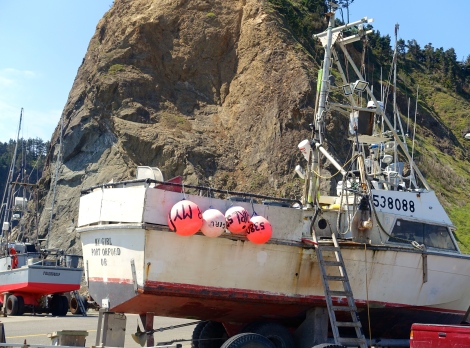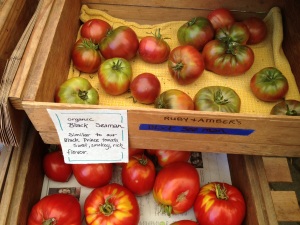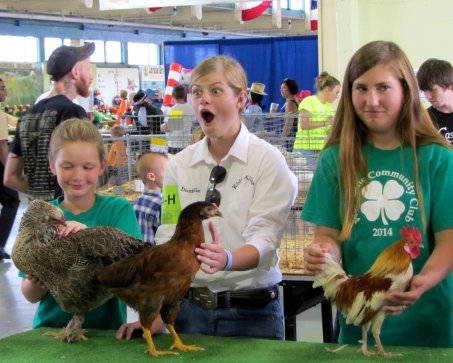
I guess I’ve put it off long enough. My house is being sold, my cookbooks are in boxes, my black raspberries are picked for the last time, my pickle jars are washed, and my heart is struggling with goodbyes. I’m leaving you, Eugene.
I decided a couple years ago that it was time to take the hard next step in my journey to becoming a full-time writer.
But where should I base myself, thought I, and how should I do it?
Trying to answer that took me many different places. If you’ve never been hit by the thunderbolts of fate that crumble your life — divorce from a 20-year relationship, losing your job and home you loved, suffering disability from a serious car accident — you may not understand this. Rebuilding becomes a Choose Your Own Adventure.
Do you settle into the old patterns, especially if they are good?
Though it’s not perfect, I mused, I liked my life in academia. I teach amazing classes and am surrounded by some pretty fantastic people. Until the landslide happened, I had an extremely active research and conference travel schedule, and I was on track with my book. I pretty much stopped the academic publishing when I was laid up the first summer of the disaster with a broken leg, since Academia is an abusive, narcissistic lover that needs attention and a masochistic attachment that I just wasn’t able to devote to it. (Edited to add, since I am masochistic enough: let the record state that I did finish several articles, haha! One on the history of how libraries handled sexual material, which was published in a groundbreaking (in the world of Porn Studies, that is) collection by Duke University Press; a review essay for Gastronomica I hilariously tried and failed to edit after my emergency surgery (thanks a zillion to Darra Goldstein for her patience); and another essay on years of research on a singular and important unknown gay writer, Samuel Steward, on the way from Ohio University Press, most likely.)
But as I convalesced, I started freelancing more and more, and really loved it. Since I write and research and publish all the time, I figured, I could easily switch back tracks and start publishing even more pieces valued by the Academy…if I had to. And my personal life would improve, I thought. I had had a partner with a similar background and values to mine, and we remained friendly after our separation, so I wasn’t wholly embittered by men. I absolutely loved my garden and little cottage. I could easily see getting another professor job, preferably on the tenure track, and another man with a similar background and having a perfectly good life. A better life. Lessons learned, personal growth, blah blah blah, etc.
But there was another option that whispered to me, then grew increasingly louder and more adamant.

Or do you to ride the wave of that sea change and let the prevailing winds blow you into some new harbor? I mean, you might wash up on a beach like driftwood or a dead sea lion or velella velella, but you might actually make a difference and be even happier.
So instead of wallowing in grief or being angry at the people who took away my life (though there WAS a lot of that), I ultimately decided to let karma take its course and not to mourn the life that was taken from me. To let the current transport me somewhere else. We really don’t have a choice anyway, I concluded, and I’m kind of lazy, so I might as well choose to go along for whatever ride the universe was planning for me.

Annoyingly, I didn’t get any clear signs from the universe that it actually had a plan. For a lady who is not in the least bit spontaneous and pretty much lives a few years down the line, I found this absolutely unpleasant. Rude, in fact. I was ready to move on but the universe wasn’t ready to move me. So I ignored the growing frustrations with my seeming non-action from friends and family, and choked back my own rage at failing every single day to come up with a plan, and I continued patiently casting about for possibilities. (If this sounds at all vain and accusatory, I apologize, but I was FAR MORE sick of my inaction than you were, I promise. Inaction took up all my time and energy and the light of my life for years, and it was a miserable BFF.)


For a long time, I thought I’d live in a small building on a farm near Portland so I could continue my writing and research on agricultural changes in the Willamette Valley, but start hanging with Portland people. I briefly flirted with moving to Scandinavia and researching the idea of “north” à la Glenn Gould, but with more food…hopefully with the save haven of a study abroad program. I had almost convinced myself that I was moving to Haarlem, a small town on the coast near Amsterdam, to study Dutch still lifes, and I toy with the idea of moving to Germany or Ireland. I briefly considered moving back to my hometown of Detroit to engage myself with urban farming. I mulled over Yachats, Tillamook, Scio, Manzanita, Clatskanie, Gaston. All of these lives would have been fun and rewarding.
But Port Orford was the only one that reached out to me with a yes, and said, “not only will I welcome you, but you have no idea how strange and wonderful I am, Jennifer Burns Bright, and I’m going work with you to make your life, and hopefully the lives of others, better!”
I was sold. I like a guy with a can-do attitude.
Port Orford is a tiny, sleepy town on the Southern Oregon coast. It is one of the most fascinating places I’ve been in decades of traveling all over Oregon and the world. I cannot wait to share it with you.

I discovered the town almost by accident a few months ago. As many of you know, I’ve been doing more travel writing and have done quite a few pieces on the Central and Oregon coast, but it had been many years since I ventured southward, and then, only to Bandon. So I suggested to my editor that I go check out some of the more southern towns to see what was going on, and asked friends where they stayed down there. Someone (Brendan at Belly, so blame him) suggested I stay in the cabins at Cape Blanco, so I did. I fell in love immediately with the place, and when I discovered they had some of the most beautiful and diverse beaches I’ve seen anywhere, I started looking into some of the connections I might make with writing about Oregon seafood, long an interest of mine.
Well, it turns out that the town can help me learn. There’s the Port Orford Sustainable Seafood alliance, where fishermen are bringing local seafood and raising awareness about marine issues through a coalition of partners affiliated with an amazing non-profit, the Port Orford Ocean Resource Team, who work on marine research and advocacy. I did a couple of brief interviews of the folks there, and realized how little I – as a food writer and lover of seafood and the Oregon coast – actually knew about the coast. Like this:
What does it mean to catch a belt fish wild? How is it caught? And by whom? And does “Product of China” mean a fish caught in China? And how does it end up in Atlanta, where this picture was taken? I can’t answer these questions, and I think they should be answered.

I’ve always loved the coast, but this will give me the ability to really understand what it’s like to live and make a living on the coast in uncertain times. The town is situated 60 miles north of the California border and 27 miles south of Bandon in the so-called State of Jefferson on a wild and remote coast, but for a travel and food writer it is a good place to learn about the relationships between states and the federal government and the industrial pressures on food systems and conservation in both California and Oregon. My goal is to eventually specialize in coastal writing writ large, integrating environmental and commercial interests in managing the marine life and waterways that are so crucial to our country and planet.


Early reviews of my decision are in. Inevitably, I’ll hear three things: “Oh, that’s my favorite beach town in Oregon!” and “Why in the heck would you move there?” and “Are you sure you can live in such a small town?” And I answer “Mine, too” and “see below” and “nope, but I won’t know ‘til I try it.”
And the rest of the story is yet to be written.
I’ll still be teaching Food Studies courses at UO next year in the Departments of Comparative Literature and Humanities Program to fund the start up of this project, so it’s not a complete break. (Yes, the commute will be difficult but I’ll be fine.) I’m also managing the culinary events for the Mt. Pisgah Mushroom Festival this year, as I have mentioned and will mention again and again, so you’ll be hearing from me about that.
But other than one more post to announce my new website, where I’ll be chronicling the continuing adventures of a big small town girl in an even smaller town, I’m drawing the curtains closed on this small blog.


Culinaria Eugenius was the vehicle by which I learned about this town I love and its people. Almost 930 posts later, I can safely say it’s been worth it. Eugene has changed so much, and I am so honored to have been part of the group that helped spread the word about innovations in our food system: agricultural advances and great strides ahead in our restaurant culture. There are Facebook groups and local food magazines and a much better networking system that connects local food to people who want to eat it. I know Eugene will keep doing wonderful work and others will write all about it and I will be reading.
So it’s not really a goodbye, since Eugene is such a huge part of me (plus, I need to come here to buy weird groceries). It’s just a new adventure, and one I hope to share with you.























You must be logged in to post a comment.